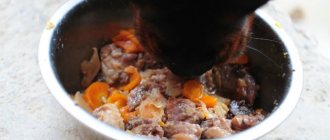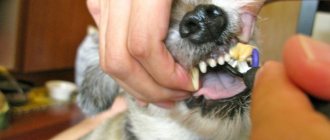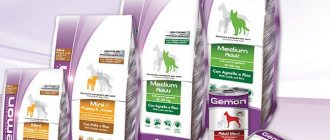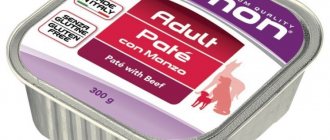Any adult knows that salt, or rather its excess, is white death. Insatiable consumption of this loose white seasoning containing sodium leads to disturbances in the functioning of the stomach, kidneys, liver, heart and blood vessels, nervous system, muscles and bones. But it is also wrong to completely give up salt in your diet, since this product has many benefits. Salt or otherwise sodium chloride prevents dehydration, gives the body vigor, allows you to digest food by participating in the production of gastric juice, and maintains the balance of calcium necessary for strong bones. The minimum allowable amount of salt per day for a person is 0.4 g, the maximum is 5 g (this is approximately 0.5 teaspoon).
So, salt can be both harmful and beneficial, so it all depends on how much a person consumes. What about our pets? Is it possible to give a dog salt? Or should animal food not contain this product at all? This will be discussed in our article.
Is it possible to give a dog salt: advice from veterinarians
In general, there are several theories as to whether it is necessary to salt your dog's food or not. As for industrial feed, which is sold in the form of canned food, everything is clear here. Manufacturers themselves made sure that the food contained sodium and chlorine ions. Usually a small amount of salt is added in production. Accordingly, such food does not need additional salt.
Can I give my dog salt?
- If the question concerns natural nutrition, when the dog’s diet includes meat, fish, and cereals that are prepared independently, then the situation here is different.
- In most cases, experts argue that a lack of sodium, as well as chlorine in the body at a young age, leads to deterioration in skeletal growth and acute disorders.
- Sodium is a trace element that is involved in the formation of bone tissue and skeletal cartilage, usually occurring before the age of one year.
- Accordingly, during this period it is still necessary to introduce a small amount of salt so that the dog has enough of it.
Doggie
Required amount
The daily requirement for each animal is individual and it consists of the parameters of growth, age and body condition.
For a large pet, for example, if it is a Rottweiler, the daily norm is 1.7 g, and for small breeds - about 0.2 g. However, adding salt is required only if the diet does not contain products that contain this component, for example, sausages, sausages.
High salt content is detrimental to your pet's health
Should dogs eat salt?
If the dog is old enough, then it is necessary to consider all options and evaluate what the dog eats. If it is raw, fresh meat, then it is not necessary to add salt. Fresh meat mainly contains blood; it contains sodium chloride in a small concentration. This is usually the saline solution that makes up dog and human blood. Accordingly, part of the sodium chloride enters the pet’s body along with the blood. This also applies to offal.
Should dogs eat salt?
- It is necessary to evaluate how often the dog eats from the owner's table. This refers to how often the pet gets a variety of goodies, such as herring, cheese, or a piece of dry-cured, smoked sausage.
- The fact is that these products contain a huge amount of salt, so 1-2 pieces a whole day for a dog will be enough to compensate for the deficiency of sodium chloride.
- Remember that such products spoil the dog’s stomach and intestines, so it is necessary to treat your dog with them very rarely. Sometimes it is recommended to give hard cheese; it also contains a large amount of sodium chlorine.
Treating the dog
Preventive measures
In super-premium food, the manufacturer calculates the exact dosage of all nutrients, taking into account the breed of the dog. After all, toy terriers, Labradors and mastiffs require different nutrition, corresponding to the size and activity of the dog.
When preparing dishes from natural food products, veterinarians allow food to be slightly salted. However, salty biscuits, sausage, and canned vegetables are contraindicated for dogs.
Teach your pet from puppyhood not to eat without the owner's permission. Many foods that are considered delicacies for humans are harmful to animals. And there may be spoiled or even poisoned food on the ground.
Few owners of four-legged pets have not once thought about whether their dog’s food needs to be salted.
. There are situations when an animal, eating a certain way, suddenly refuses some of its usual dishes and shows with all its appearance “it doesn’t taste good to me,” although it happily waits for the treasured piece of dry-cured sausage or cheese to arrive from the owner’s dining table. Is it worth torturing an animal and waiting until it gets really hungry and begins to gobble up everything in the bowl with gusto? Or is it enough to add a little salt to bland porridge or a piece of meat so that your pet stops neglecting bland breakfasts?
Should dogs salt their food when cooking?
If you treat your dog to foods from the refrigerator, semi-finished products, and processed meat products, then there is no need to salt the food you prepare.
Should dogs salt their food when cooking?
- If, nevertheless, the dog is on a natural diet, but there is very little fresh meat in the diet, mainly boiled porridge, bone broths, and soups, then it is necessary to introduce salt, but in small quantities.
- It should be about 3 times less than for yourself. That is, salt is necessary, but in much smaller quantities. Please note that salt is white death, and indeed the consequences of an overdose for a dog are much worse than for a person.
- If we can afford to regularly consume large amounts of salt and not observe chronic diseases of the bladder and kidneys for a long period of time, then in dogs the disease develops and progresses much faster.
Water
They don't need innovation
Can a dog taste spicy food? Dogs have about 1,700 taste buds (humans have 9,000), and they are not as sensitive to taste as humans, according to the American Kennel Club. Simply put, dogs still won’t appreciate spicy food. They won’t feel the difference, but they will experience gastrointestinal upset. If you want to diversify your pet's diet, this can be done without human products. For example, you might offer your dog his favorite food in a new flavor, but in reality, he'll be fine with eating the same food every day. And don't forget that dogs have a keen sense of smell. If you've ever smelled cumin powder, you know what a strong smell means. Now imagine that the dog will smell this smell even more acutely. Some spices that even make you watery can have a much stronger effect on your pet.
Pet owners perceive them as full members of the family. But feeding is not the case. Don't risk your dog's health by offering him your food, especially spices. The dog should only eat special food.
Salt poisoning in dogs
It is enough just to overfeed him with salty food a few times, the reaction will not take long. In most cases, very serious problems arise with the functioning of the kidneys and bladder.
Salt poisoning in dogs:
- Stones may appear in them, or fluid loss may worsen, with the formation of edema. Please note that if you do add a little salt to your food, be sure to take care of a bowl of water. There should be a lot of it, since after taking salt the dog can become dry. It is imperative that it replenishes the fluid deficiency.
- Remember, if you give your dog fermented milk products, that is, kefir, cottage cheese and cheese, then there is no need to add additional salt. Many radicals say that wild dogs are relatives of dogs and wolves, do not consume salt and live long lives.
- In fact, the body of domestic dogs is significantly different from wild dogs, but wild animals also receive salt. It is found in large quantities in the blood. Since the main diet of wild animals is small living organisms, mainly rodents and rabbits, their blood contains sodium chlorine. It is the basis of all fluids in the body.
Dogs
What are the dangers of using the product for animals?
Everything is good in moderation; if a pet receives too much salt for a long time, an excess of it occurs in the body. This may cause the following consequences:
- Fluid accumulation. The function of maintaining water balance is disrupted, too much water accumulates in the tissues, swelling and bloating occur.
- For these reasons, the blood thickens, which disrupts the functioning of the cardiovascular system. Over time, due to heavy stress, the cells of the organ will begin to destroy, heart failure, shortness of breath, and changes in pulse will appear.
- An increase in water in the body leads to an increase in blood pressure; it also affects the functioning of the heart and the vascular system as a whole.
- The work of the hypothalamus (the area in the diencephalon responsible for the integration of nerve impulses from various systems) decreases.
- The risk of osteoporosis increases (the body loses too much calcium).
- Accumulated salt interferes with the functioning of the kidneys, leading to the formation of stones.
A large dose of sodium chloride can lead to salt poisoning. A pet is unlikely to eat a large amount of the product on its own, but adding it to food is dangerous for the animal’s life. Rapid dehydration leads to disruption of most internal organs. For a dog, the lethal dose is 3-4 grams. substances per kilogram of weight.
Can dogs salt their food on a natural diet?
Another thing is that a pet cannot consume raw meat every day; not all dog breeders have the means to purchase such products. If this is meat sold on an industrial scale in stores, then in most cases it contains salt.
Can dogs salt their food on a natural diet?
- Many sellers soak meat in salt water to increase its weight. Accordingly, there is no need to introduce additional salt in this case. If the meat was bought secondhand from a farmer you know, then it is necessary to add salt to such food.
- Let us give an example: in all Soviet nurseries, dogs were fed with the introduction of salt. When preparing food, it was added in an amount of half of the norm that people administer to themselves. All dogs grew up healthy and strong.
- Accordingly, a small amount of salt is still acceptable. Under no circumstances add enough salt to yourself. Introduce sodium chloride in small amounts so that it is barely noticeable in taste.
Cutlets for dogs
Daily dose
Salt is a natural flavor enhancer that is initially present in many products. Many dogs, accustomed to salty food from birth, subsequently refuse salt-free dishes, which forces them to add additional salt to their food. This most often leads to an overabundance of the substance, which has an extremely bad effect on the functioning of all internal organs and systems.
Scientists believe that the daily dose for an adult healthy dog is 0.0001 g per 15 kg of weight. At home, it is almost impossible to accurately measure the required amount. Therefore, veterinarians advise that if you salt food, it should be done so that a person cannot feel the taste.
- Raw meat.
- Raw lard.
- Kefir.
- Buckwheat.
- Cottage cheese.
- Parsley.
If you avoid these products or feed salt-free dry food, then to ensure that your pet receives the required dose, it is enough to give a piece of pickled cucumber or sausage once a week.
Should dogs' food be salted when cooking?
Many people believe that a dog should also taste food, and without salt it is completely tasteless. In fact, a dog's taste buds are different from human ones; they are less sensitive.
Do dogs need to salt their food when cooking?
- If you add more or less salt, the dog is more likely to not understand. Therefore, salt in this case is added only as a way to introduce nutritional components such as sodium and chlorine.
- Chlorine is a harmful chemical element, but it is involved in all processes in the human and dog body. With its help, hydrochloric acid is formed in the stomach. Therefore, without this component there may be problems with digestion.
- Sodium whole blood kidneys chlorine brains skin light whole blood kidneys and liver.
With a pet
Induce vomiting
Regular table salt can be used as an emergency remedy if your dog has eaten something wrong. In order to induce vomiting, open the dog's mouth, fix the tongue and place half a teaspoon of salt at the very root of it.
As a rule, the reaction will follow immediately. There is no need to be afraid that the situation will only get worse: during nausea, the dog’s pylorus closes and the absorption of toxic substances stops.
Reference! Vomiting can also be caused by a solution of potassium permanganate or copious gastric lavage.
Should I salt my dog's food every day?
If every day some salty food is included in the dog’s diet, then there is no need to introduce additional salt. This rule only applies if offal and meat are given raw, that is, not boiled.
Should you salt your dog's food or not?
- Many fans of natural nutrition claim that wild breeds did not consume salt. Many note that the dogs that guarded the sheep were constantly with the shepherds, receiving practically no food.
- Almost everything they ate was of natural origin. These are small animals and insects. Often shepherds fed their assistants with cakes dipped in whey. Accordingly, salt was present in large quantities in such food.
- If the dog is factory fed, then there is no need to add salt. If you are feeding your dog treats from the table, you do not need to add additional salt to the food you are preparing. If you strictly monitor your dog’s diet and don’t give anything even as a reward from your table, then you need to add salt only in a small amount, about 3 times less than you add to yourself.
meal
Is it possible to feed chicken by-products?
Feeding a dog chicken by-products is a double-edged sword, and even veterinarians do not have a consensus on this matter. On the one hand, in their raw form they can contain harmful bacteria, antibiotics, and other harmful additives. On the other hand, when boiled, the nutritional value is lost.
The issue is especially controversial with chicken heads, paws and other parts containing bones. Boiled bones are not recommended.
Chicken heads
Disputes about whether it is possible to give chicken heads to dogs do not subside on dog breeders forums. Many pet owners say that they give their dogs chicken heads as the main source of protein daily, and the four-legged animals feel great. Proponents of such nutrition remind us that in nature a predator eats its prey with its head, and this does not cause any harm to it.
And although there are no tubular bones in the head, veterinarians do not advise doing this. If you decide to give your animal chicken heads, do not do it every day. The head has little protein and a lot of bones; it cannot replace meat. The beak must be removed. It contains nothing useful and is dangerous for the esophagus.
Dog owners living in rural areas should also remember that a dog accustomed to chicken heads may one day break loose and run out into the street. Such an animal is almost guaranteed to kill all the chickens and other poultry it encounters.
Necks can be fed even to a puppy older than 3-4 months. They do not contain tubular bones.
Paws
Paws are another very controversial by-product. They contain a lot of collagen and have a rich amino acid composition. Collagen is good for joints, skin and coat.
At the same time, the paws contain those very tubular bones that should absolutely not be given to a dog: their fragments can puncture the esophagus.
If you are going to give your pet chicken feet, remove the bones from them, cut off the claws, and pour boiling water over the feet. You can remove the bones and cook jellied meat from the paws. Jellied meat is beneficial for growing puppies.
Wings
The wings contain the most bones and skin. Giving leather to dogs is not advisable. Therefore, using wings as feed is not recommended.
Bones
Tubular chicken bones should not be given to dogs. They can form sharp chips and damage the intestines. This is especially dangerous for puppies and small breeds.
It is not advisable to give your dog boiled bones. Raw bone in a dog's stomach is successfully digested. But boiled food is not processed and leads to constipation. All valuable substances in bones are destroyed during heat treatment. A boiled bone is essentially rot that does not contain anything useful, but it settles in the stomach and intestines and can accumulate there.
It is recommended that dogs be given raw bones to chew on: it is good for the teeth and skeletal system. However, it is better to choose beef bones rather than chicken.
Stomachs, hearts
Chicken stomach and heart contain many healthy vitamins and protein. This food improves the pet’s fur: it takes on a healthy appearance. Use stomachs and hearts as a base for broth, porridge, and add them to vegetables.
Liver
Liver contains a lot of vitamins B12 and A. Boiled liver is very useful, but give it little by little to avoid hypervitaminosis and bone deformation.
Should I add salt to my dog's food: reviews
If you additionally give your dog vitamins prescribed by the veterinarian, there is no need to introduce salt. Typically, chlorine, as well as sodium, are contained in vitamin preparations in the required quantities. Below you can read reviews from dog owners.
Should I add salt to my dog's food? Reviews:
Eugene . I have a German Shepherd, so I cook my own food. I don’t buy food, I don’t think it’s of the highest quality. I don’t salt my food, since my girl’s diet often includes a large amount of raw meat. I think that my dog feels great; it is not necessary to introduce salt.
Elena, owner of the Pekingese . I buy food for my dog and very rarely give him treats from the table, such as cheese and sausage. I try not to overuse it, since once my Zhuzha got poisoned from such food. I don’t salt my food, I feed it mostly with food.
Alexey, owner of a husky . When I got a dog, I had no idea that a large number of questions and problems would arise. Initially, we kept the dog on food, but then the financial situation worsened, now we cook on our own. We often introduce raw meat. I add a little salt to my food. I add a very small pinch, 3 times less than for myself. The dog is healthy.
Puppies
As you can see, responsibility for the health of pets lies with their owners. Everyone decides for themselves whether the dog needs to be given salt or not. Veterinarians and specialists have not come to a consensus regarding the addition of salt to a dog’s diet.
What you need to know to avoid harming your pet
So, let's sum it up!
Salt is an important trace element that helps the proper functioning of all internal organs. And it is not surprising that a caring dog breeder tries to do everything right so that his pet is healthy and happy. And, if the tail refuses to eat bland food, the loving owner rejoices when the dog begins to eat with pleasure, as soon as a pinch of salt appears in the food.
That is why the question arises in the minds of many pet owners: is salt healthy for dogs and whether it should be included in the diet. However, before you decide whether to salt your food or not, remember!
The line between salt deficiency and excess is very thin!
So what you definitely need to know in order not to harm your pet:
- If you feed your dog dry industrial food, salt should be completely eliminated. All industrial feeds are packed with sodium and preservatives for long-term storage. This is why dogs eating dry food drink much more than their “naturalist” counterparts.
There is no salt or preservatives only in fresh natural products, the shelf life of which is limited to a short period of time. Or the amount of salt is minimal.
- Think about how often a pet gets food from the owner’s table?
How often do you give him store-bought treats and treats? And in general, where do you buy food if your tail eats natural food? If a dog is given a piece of cheese, sausage or lightly salted fish as a treat (or during training), most of the salt has already been received by the body. Yes, dogs are simply “shaking” in anticipation of such salty delicacies. And nothing bad will happen from one piece of sausage.
Remember! Systematically feeding a four-legged animal with salty “delicacies” from the owner’s table poses a huge danger to the life and health of the animal.
Kidney stones and cystitis are “faithful companions” of dogs that often eat too salty foods.
- There is also no need to add additional salt to your food if you are preparing food from store-bought products (this was described above).
Do not forget that the dog should have clean water in sufficient quantity and free access. If the amount of salt in the watchdog’s body increases sharply, you will immediately determine this by how quickly the drinking bowl is emptied.
And, in conclusion, I would like to say: there are no universal tips and recipes for proper nutrition. Whether your dog's food should be salted or not is up to you! For each animal, the diet must be selected individually! The most important thing to remember is that everything is good in moderation!
How to pickle lard
Cataracts in dogs, cats and other animals
At home, lard can be salted in three main ways:
By the way, no matter what method you choose, you will need to store the finished lard in the freezer.
- 1 kg of lard;
- 200 g salt;
- 20 g ground black pepper;
- ½ head of garlic.
Preparation
Cut the lard into cubes 4–5 cm wide.
Make cross cuts in each block. The depth is slightly more than the middle of the piece.
Pour all the salt into a deep container. Put lard there and rub well with salt on all sides.
Sprinkle pepper on top. If desired, you can use a mixture of red and black.
And cut the garlic into slices 1-2 mm thick and place them in the slits on the pieces of lard.
Transfer the lard into a container and refrigerate for 3-4 days.
The lard is ready. It tastes best with black bread.
For further storage, scrape off or rinse off excess salt, wrap the lard in a cloth, place in a bag, and then in the freezer.
- 2 kg of lard;
- 5 glasses of water;
- 200 g salt;
- 1 head of garlic;
- 4 bay leaves;
- peppercorns and other spices - to taste.
Preparation
Wash the lard, dry it and cut it into small pieces so that they fit easily into the neck of the jar. The optimal thickness of the piece is 5 cm.
Prepare the brine. Pour 5 glasses of water into a saucepan, add salt, put on fire and bring to a boil. Remove from heat and cool.
Finely chop the garlic and rub it over the pieces of lard. Wash and dry the bay leaves.
Place the lard in a jar. Do not try to stack the pieces tightly: the lard may go rotten. Layer layers of lard with bay leaves and black pepper.
After this, remove the lard from the jar, dry with paper towels and rub with spices. You can use ground red pepper, cumin, paprika. Then wrap the lard in paper or a bag and put it in the freezer. In a day the lard will be ready.
- 1 liter of water;
- 2 handfuls of onion peels;
- 3 bay leaves;
- 200 g salt;
- 2 tablespoons sugar;
- 1 kg of lard with a layer;
- 4 peas of allspice;
- 3 cloves of garlic;
- paprika, mixture of peppers - to taste.
Preparation
Pour water into a saucepan, add washed onion peels, bay leaves, salt, sugar. Bring the resulting mixture to a boil, add lard to it and cover with a plate so that it drowns in the liquid.
Bring the mixture to a boil again and then cook for another 20 minutes over low heat. Then remove the pan from the heat, cool and place in a cold place for 12 hours.
Take out the lard, dry it and rub it with a mixture of chopped garlic, paprika and a mixture of peppers. Wrap the finished lard in film or a bag and put it in the freezer.
Before serving, keep the lard at room temperature for 5 minutes and cut into thin pieces. This lard goes best with black bread and mustard.
Salt them, or what? :
Expression of bewilderment at excessive persistence in preserving accumulated material things. For example: - Tell me, Victor, did you feel sorry for giving your shirt to the first person you met? - Why should I salt them or something? Of course I don't mind!
Pickling
- a method of canning using salt, the high content of which in products impedes the development of bacteria and molds, the waste products of which make food inedible for humans or lead to spoilage of non-food products.











